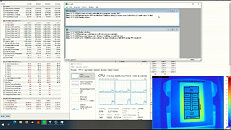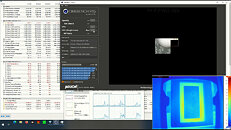Friday, May 21st 2021

Intel Core i5-11400 Runs Without a Cooler Under Thermal Camera
Famous chip photographer Fritzchens Fritz has always surprised us with some awesome die shots of the latest processors. Today, he has prepared another interesting surprise for all technology enthusiasts. Mr. Fritz has managed to run Intel's Core i5-11400 "Rocket Lake" processor without any type of colling solution, and use a thermal camera to capture what is happening inside the silicon. As the Rocket Lake design is impossible to run at any low-power setting, the author has made some changes to get a sustained run from the CPU. For starters, he set the operating clock speed to the constant 800 MHz, with iGPU, AVX, and HyperThreading disabled. The VCCSA was offset by -0.200 mV and the memory speed was lowered to DDR4-1333 speed.
The results? Well, the CPU has managed to run some tests without a cooler, and the thermal camera shows us just how the CPU works. As a CPU core gets in use, a thermal camera picks it up and we can see a core sort of spiking. Its temperature increases and it becomes distinctive from the rest of the die. After some time, the CPU became unusable, which is to be expected given that Rocket Lake's power-hungry design managed to survive quite a long time without any sufficient cooling.You can check out the YouTube video below and see the magic happen.
The results? Well, the CPU has managed to run some tests without a cooler, and the thermal camera shows us just how the CPU works. As a CPU core gets in use, a thermal camera picks it up and we can see a core sort of spiking. Its temperature increases and it becomes distinctive from the rest of the die. After some time, the CPU became unusable, which is to be expected given that Rocket Lake's power-hungry design managed to survive quite a long time without any sufficient cooling.You can check out the YouTube video below and see the magic happen.


25 Comments on Intel Core i5-11400 Runs Without a Cooler Under Thermal Camera
IHS prevents chip from cracking due to thermal dilatation prematurely but other than that there is no mechanical constraint.
www.techpowerup.com/268501/amd-renoir-processor-run-without-any-cooling
i5-11400: ST 106, MT 116 // destroyed
R3 4300U: ST 124, MT 327 // stable
Heatspreader area is probably not that different, but maybe in a laptop it's more likely to throttle safely.
Would be great to compare with Tiger Lake U or Ice Lake U...
Heck I ran Borderlands on it. It throttled a bit and then I found out :P
Also, why does the area surrounding the die seem hotter than the die itself? The effect is the same on chips that have no IHS at all, for example the Ryzen 4300U.
People always complain about the current gen not bringing enough improvement compared to the previous one. They just forget about the fact that you aren't meant to upgrade with every generation nowadays.
Just like what you see with Nvidia GPUs these days, why wouldn't that be possible for a CPU?
www.techpowerup.com/gpu-specs/geforce-rtx-3090.c3622#gallery-2
Graphics cards come with coolers attached, which makes the warranty process a lot simpler in most cases. With CPUs, there's a million options for cooling, and you basically need an aftermarket cooler in most cases anyway, so the chance of cornering a die would be much higher with no IHS on it.
Or something else, I'm just guessing. It would sure be nice to see, though. :)
Here's my wild guess: it's the copper wires and power planes on the various layers of the substrate that are feeding large currents to the entire chip. They don't dissipate very much power and that power isn't concentrated in hot spots, but these conductors aren't cooled either, so they can reach quite high temperatures.
Canned air would show up in that case as it's cooler and would lower the temperature.
Edit: Even the i5-10600K/KF is built on a 10-core die.
After being a PC Pro for 15yrs it was studying data science when I really gained a good understanding of how a CPU works and how the multiple cores are accessed.
This is what gives GPU's the advantage with certain tasks as the same instructions can be run in parallel (as we all know), where as a CPU only accesses one core at a time... all be it very quickly.
It still has to use the cores individually. It was fascinating seeing each of the cores being used and the speed each core was accessed after the one before. Brilliant video!!!
Your 5950X is able to run up to 16 independent threads of program code at the same time, or up to 32 with lower performance.
What Fritz did was starting Prime95, then telling Windows to allow it to run only on a specific core. The default is all six cores - however, a process with less than six threads could never use all of them in parallel.